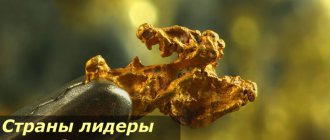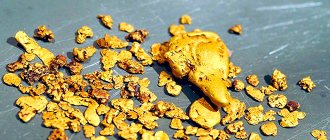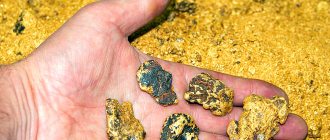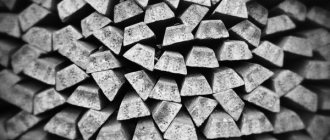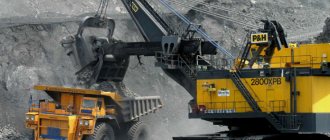Industrial gold mining is predominantly concentrated on extracting the precious metal from ore, but alluvial gold mining is also highly developed in Russia. From a material point of view, mining precious metals in this form does not require large financial expenses. You don’t need to buy expensive equipment and dig up tons of rock, because alluvial gold mining has changed little since ancient times. Therefore, in fact, everyone who has an interest in this matter could search for golden grains of sand. But in the Russian Federation, unauthorized artisanal gold mining is prohibited at the legislative level.
However, those who want to become miners still have a way out of this legislative impasse. They can work for gold mining companies that have an official license to operate. As a rule, such companies are engaged in the development of primary deposits, but are happy to hire people to mine placer gold. How do these two types of gold differ from each other and what are the methods for extracting placer deposits of this precious metal? Let's look at these and other questions.
History of gold mining in Russia
The history of Russian gold mining goes back about three centuries.
Before this, for many centuries, gold was purchased abroad, spending their national wealth on it. Although back in the 5th century BC, the “Father of History” Herodotus claimed that in the Urals (at that time they were called the Riphean Mountains) there were significant reserves of this noble metal. And indeed, while uncovering ancient Scythian burials, secret diggers - “hillsters” discovered many unique gold items from a vanished civilization.
Since the 40s of the 18th century, the situation has changed radically. Gold has already been discovered in Altai, in Karelia at the Voitsky copper mine, and in the Arkhangelsk province they found a gold mine, from which 65 kg of the precious metal was subsequently extracted over half a century.
But still, the first industrial deposit was the Shartashsky mine (later on - Initial), discovered in 1745 by Erofei Markov. By the middle of the century, the Berezovsky mine, which arose on its basis and included 50 mines, produced 16 kg of gold. By the 60s, production amounted to 32.6 kg, by the 70s – over 65 kg. And in 1806, 5.8 tons of gold were produced, which at that time accounted for 85% of all production in the state.
Gold mining received further development much later than Catherine II’s decree of 1782, which declared a state monopoly on the development of metals. Although during the second half of the 18th century, yellow metal was found on all slopes of the Ural Mountains, except the north. The discovery of large nuggets on the Chusovaya River, the gold reserves of which continue to be developed to this day, was significant.
The decree of Alexander I, which opened up freedom in the extraction of precious metals, made it possible to begin the development of placer deposits using the technologies of Lev Brusnitsin. His discovery of the Ufaleysky primary deposits and successful research on the Berezovka River led to a gold rush in Russia. 200 new alluvial deposits, the first place in terms of gold production in the world, and constant improvement of technology have led to a sharp increase in mineral production.
The noble metal was rediscovered in Altai, Western Siberia, in the Vyatka province. In the future, fishermen and ore miners increasingly rush to the east. The Yenisei region, Transbaikalia, the Amur region, and Primorye are becoming new gold mining areas. The Lena, Kolyma and Chukotka river basins are added to them.
During the time of the Russian Empire, 2,644 tons of gold were extracted from the bowels of the earth. The same figure during the existence of the USSR was 10,985 tons. From 1991 to 215, gold production amounted to 4404.1 tons.
Gold plates
Bureaucratization of the licensing process for certain types of activities
Amendments made to Law No. 99 of 05/04/2011 “On licensing of certain types of activities” in the column (Article 3 p.) required, when involving new areas and deposits in the work, to re-issue numerous licenses (for the right to carry out surveying work, for the right to carry out activities , related to the application of VM for the implementation of the activity “Operation of explosion-, fire-hazardous and chemically hazardous production facilities”, etc.) With short periods of development of alluvial deposits in conditions of an extremely depleted raw material base, many enterprises are in a state of constant re-issuance of licenses.
required, when involving new areas and deposits in the work, to re-issue numerous licenses (for the right to carry out surveying work, for the right to carry out activities , related to the application of VM for the implementation of the activity “Operation of explosion-, fire-hazardous and chemically hazardous production facilities”, etc.) With short periods of development of alluvial deposits in conditions of an extremely depleted raw material base, many enterprises are in a state of constant re-issuance of licenses.
Law No. 99FZ introduced a new concept “place of implementation of a separate type of activity subject to licensing (hereinafter referred to as the place of implementation of the licensed type of activity)”, which means an object (room, building, structure, other object, while the legislator did not provide an interpretation of the concept “other object »
), which is intended for the implementation of a licensed type of activity and (or) is used in its implementation, meets licensing requirements, belongs to the license applicant or licensee by right of ownership or other legal basis, has a postal address or other data allowing the identification of the object. The location of the licensed type of activity may coincide with the location of the license applicant or licensee.
Based on the content of this concept, such an object cannot be a city, a region of the Russian Federation, a subject of the Russian Federation or the Russian Federation as a whole. The object is buildings, premises, structures or other objects that fall under the concept of “place of implementation of the licensed type of activity”, owned by the license applicant or licensee by right of ownership or other legal basis.
To resolve this issue and eliminate unnecessary bureaucratic procedures, the Union of Prospectors of Russia proposed adding to Art. 3 (clause of Law No. 99 of 04.05.2011 “On licensing of certain types of activities”, addition and formulate it as follows: “the place of implementation of a certain type of activity subject to licensing (hereinafter referred to as the place of implementation of the licensed type of activity) is an object (premises , building, structure, other object) that is intended for carrying out a licensed type of activity and (or) is used in its implementation, meets licensing requirements, belongs to the license applicant or licensee by right of ownership or other legal basis, has a postal address or other factors allowing to identify the object data.
3 (clause of Law No. 99 of 04.05.2011 “On licensing of certain types of activities”, addition and formulate it as follows: “the place of implementation of a certain type of activity subject to licensing (hereinafter referred to as the place of implementation of the licensed type of activity) is an object (premises , building, structure, other object) that is intended for carrying out a licensed type of activity and (or) is used in its implementation, meets licensing requirements, belongs to the license applicant or licensee by right of ownership or other legal basis, has a postal address or other factors allowing to identify the object data.
In terms of deciphering the concept of “other object”, indicate: “The place of implementation of the licensed type of activity for alluvial enterprises is a geological alluvial ore area, which may be located on the territory of several administrative districts and may coincide with the location of the license applicant or licensee.”
The absence of a decipherment of the concept of “other object” creates the most favorable conditions for corruption of officials, despite the fact that Article 9 of Law No. 99FZ, paragraph 2, directly states: “A legal entity or individual entrepreneur that has received a license has the right to carry out the activities for which the license is granted, throughout the territory of the Russian Federation and in other territories over which the Russian Federation exercises jurisdiction in accordance with the legislation of the Russian Federation and international law, from the day following the day of the decision to grant a license.”
Extraction methods
Washing of placers
The oldest method of gold mining, based on the high density of the mineral. Using a tray, miners wash gold-bearing sand by hand, sifting out lighter rocks. This produces a heavy fraction called concentrate, which requires further processing. Sometimes it contains other valuable metals and stones.
More modern technologies for washing placers or bedrock use dredges and industrial washing plants, which can significantly increase the productivity of the process.
Extraction of gold from rocks through amalgamation, chlorination or cyanidation
Amalgamation is a method of extracting gold by forming compounds of highly concentrated mineral rocks with mercury. After this, the amalgam is extracted from the sludge and separated into gold and mercury, which is then reused.
Cyanidation uses the dissolution of gold in cyanide (solutions of hydrocyanic acid or its salts). The precious mineral is then deposited using ion exchange resins or zinc dust. The same process used to deposit gold on sorption columns and return the recovered cyanide to reuse is called heap leaching.
Chlorination of gold is a method known to the inhabitants of pre-Columbian America, based on the dissolution of the mineral in chlorine with its further conversion into a gas that is precipitated and dissolved by water. This allows you to concentrate the metal in the right place. There are also options for pure gas technology. By heating a mixture of gold ore with table salt and clay, the Indians obtained a huge amount of gold for those times.
Industrial
Extraction of gold-containing ores from the earth's crust to the surface, from various depths, is carried out by open or closed methods. Preliminary geological exploration determines the presence of gold-bearing layers and the feasibility of their development.
Shakhtnaya
The mining technology using the mine method is quite labor-intensive. In addition to the construction of the underground structures themselves, the development of frozen soils and the removal of melt water is required. With the introduction of longwall mining techniques and the use of modern technical devices (belt conveyors, hydraulic units, steam needles), the process has become significantly more efficient. Labor productivity has increased and rock yield has increased.
The undoubted advantage of this method is the possibility of developing gold deposits with a depth of 10 m. Sometimes permafrost is a favorable factor for mining ores in this way.
Career
The process involved in removing the top layer of waste rock and mining the gold-bearing layer of soil. In case of high hardness of materials, drilling and blasting technologies can be used. The ore mined by excavators is loaded onto vehicles, which is then sent to processing plants. Where its further development takes place.
Highly specialized techniques
Gravitational differentiation method
One of the oldest, but still relevant, methods of extracting gold from rocks, used in most modern enterprises. Its essence lies in the preliminary grinding of ore with heavy cast iron balls inside rotating mill drums. Then, in centrifuges, the fractions are separated into a light part and a heavy part (richer in gold). After which both are subjected to processing processes corresponding to their properties.
Using a metal detector
Constant technological progress makes adjustments to the ancient process of searching for minerals. One of these advances, which greatly facilitates the search for metals, is metal detectors. Moreover, modern designs of these devices allow specialization for specific chemical elements. Despite all their shortcomings, these devices make it possible to detect large fractions of yellow metal, as well as its nuggets. Therefore, we can safely conclude that metal detectors have a great future in mineral exploration. Including gold.
Using the flutter
A technology used primarily to capture the smallest gold particles. Well crushed rock is poured with oil and mixed thoroughly, adding water. As a result, light “fatty” particles end up on the surface. It is not difficult to remove them from there and clean them, say, using subsequent cyanidation. In industrial production, to increase the productivity of the process, the mixture is purged with air.
Deny cannot be saved
But in addition to purely economic and bureaucratic difficulties, subsoil users could potentially face a much more serious problem - a ban on alluvial gold mining due to environmental restrictions.
Alluvial gold is mined in reservoirs; dredges stir up the water, which becomes a great stress for the ecosystem. Hence, calls periodically arise to limit or completely ban the development of gold placers.
Once again there is a choice between economics and ecology. However, we must not forget about the people who live in single-industry settlements, where gold mining is the only source of income. Vladimir Makarov believes that banning alluvial gold mining, as some “hot heads” propose, is, to put it mildly, unwise.
At the same time, he sees the environmental risks of placer gold mining, but is confident that they can and should be minimized by observing technological standards and regulations.
“Chemical reagents are not involved in the placer mining process. When developing placers, it is easy to purify the water using normal circulating water supply. Technologically, this can all be solved. It is clear that many enterprises go for direct leaching without creating settling ponds, as this reduces the cost of production. We need supervision, and it is possible to achieve compliance with all environmental standards.
I don’t think it’s difficult to do this now with powerful tracking tools. This is filming from space and from drones, meaning you don’t even have to come to the place. Everything is real, the main thing is to remove the corruption component,” Vladimir Makarov is convinced.
Let us remember that Russia is the only major gold-mining country that maintains a high share of alluvial gold. The question arises: is it because other countries treat nature more carefully and adopt more severe laws?
It must be said that replicating foreign experience in Russian spaces is in fact not so simple. For example, in Canada or Australia it is much easier to buy or sell a license than in Russia. A prospector in Australia receives a license for $35-40 and can start looking for nuggets with a metal detector in his hands.
There is even tourism with gold mining, that is, for some people it is just entertainment or a hobby. Nevertheless, placer gold mining in these countries is declining.
The main reason is its low profitability. Some states are actually tightening environmental legislation in the field of placer gold mining. The largest example is China, although the Celestial Empire made this decision because the deposits are concentrated in densely populated areas of the country.
On the other hand, some African countries are even increasing alluvial gold mining, since the costs of mining placers are relatively low.
“It is clear that in densely populated economic areas, placer gold mining should be limited, and possibly prohibited. But, for example, in the Magadan tundra or in the north of Yakutia, I don’t see any obstacles to this. In addition, in the yet undeveloped regions of Siberia and the North, new entire gold placers may be discovered,” Vladimir Makarov shares his opinion.
Photo: amur-gold.ru
Production in the cold season
The specificity of developing gold deposits during low temperatures has a number of significant advantages:
- Solving a number of transport problems not burdened by spring-autumn thaw and damp summer soil.
- The absence of significant groundwater flows and a decrease in the level of surfaces of reservoirs.
- Favorable opportunity to remove forest shrub cover and remove hard soil.
- Improving the optical characteristics of the desired mineral.
In general, it can be noted that gold mining at one time or another of the year is most appropriate, taking into account the specific circumstances of organizing the process at the location.
Applications of gold
Jewelry industry
Due to its unique aesthetic properties, gold has always been used as a material for the manufacture of exquisite jewelry. Over the centuries, the situation has hardly changed. A significant part of this noble metal ends up in the hands of jewelers who create a variety of jewelry.
However, pure metal, due to its softness, is unsuitable for these purposes. Alloys of gold with copper and silver have proven themselves much better; with additives from non-ferrous metals. This mixture of chemical elements makes it possible to obtain raw materials of the required strength and the desired color shade.
It has become common practice to stamp finished jewelry to indicate its fineness—the content of gold (or other precious metal) in the alloy being hallmarked.
Gold
Investment
Due to a number of historical reasons and physical characteristics: durability, resistance to corrosion, gold has become the most important element of the financial market and the largest source of investment. It can be stored almost indefinitely, and the liquidity of this metal remains constant for centuries. This turns this mineral into one of the most convenient options for investments and long-term savings.
State gold and foreign exchange reserves
One of the areas of use of the described precious mineral is the formation of gold and foreign exchange reserves, which represent highly liquid assets, which include gold in the form of coins. It should be noted that these funds are under the control of government authorities.
Coinage
The use of gold as a national (sometimes international) currency has an ancient history. Moreover, in the 19th and early 20th centuries, all world currencies were tied to a single gold standard. And today, many countries around the world mint investment and commemorative coins based on very high-grade gold. Although paper banknotes have long become the main means of circulation.
Technology and industry
The technical use of the mineral is based on the use of a number of its special properties: softness, malleability, ductility; high electrical conductivity, resistance to chemical influences, reflectivity. The areas of application of this noble metal are:
- Transport.
- Chemical industry.
- Energy.
- Instrumentation and electronics.
- Telecommunications.
- Nanotechnology.
- Nuclear physics.
- Production of modern weapons.
- Cosmonautics.
Food production
Cooking boasts an exotic use for gold. It is here that the exquisitely refined tastes of gourmets are activated under the influence of gold leaf decorations that are part of the manufactured products. This mineral is also used as an original food additive for drinks and food. Which becomes a kind of means of attracting very wealthy clients to the most expensive restaurants on the planet.
Dentistry
This branch of medicine uses gold as a material for dental prosthetics. This becomes possible due to the chemical inertness of the noble mineral and its plastic properties.
Pharmacology
In pharmacology, gold is used to treat autoimmune diseases and cancer.
Lack of interest of government officials in replenishing SME placers
It is interesting that the state has such an interest, but the officials representing it do not. The state receives huge amounts of money from the sale of licenses. Examples of 2021: in the Amur region per stream. Comb winner with a starting payment of 90 thousand rubles. paid almost 200 million rubles, exceeding the starting price by 2218 times! This, of course, is a peak figure, but numerous cases have been recorded when starting payments are exceeded by 50–100 times. At some auctions, winners have already shelled out more than 1 billion rubles for small placers! Funding for prospecting work at alluvial deposits stopped a long time ago. It turns out that the interests of the state and government officials in resolving this issue radically diverge. Under Soviet rule, huge amounts of money were invested in geological exploration, and the country became one of the world leaders. Nowadays we are consistently turning into a third world country, gradually losing the accumulated Soviet legacy.
Deposits in Russia and the world
The list of the world's largest gold deposits is headed by:
- Sukhoi Log. Irkutsk region, Russia The estimated reserves of this deposit are 2700 tons!
- Las Cristinas. Suburb of Las Claritas, Venezuela. 480 tons of reserves.
- Xilin Mine. Shandong Province, eastern China. 382 tons.
- Vasilkovskoe. A suburb of Kokshetau, northern Kazakhstan. 360 tons.
- Bakyrchik. Eastern Kazakhstan. 200 tons.
- Witwatersrand. SOUTH AFRICA.
- Muruntau. Uzbekistan. The largest open-pit gold mine. Residual reserves amount to 1,750 tons.
- Grasberg. Indonesia.
- Goldstrike. State of Nevada, USA.
- Cortes. State of Nevada, USA.
- Pueblo. Viejo. Dominican Republic. 183 tons of deposits.
- Yanacocha. Peru.
- Carlin. USA.
- Peñasquinto. State of Zacatecas, Mexico.
- Veladero. Chile and Argentina.
- Lihir. Papua New Guinea.
- Boddington. Western Australia.
- Berezovskoye field. Russia.
The largest gold mining companies in Russia
The results of 2021 ranked the leading Russian gold miners in the following order:
- 1st place – PJSC Polyus.
- 2nd place – Polymetal Group of Companies.
- 3rd place – KinrossGold.
- 4th place – Petropavlovsk Group of Companies.
- 5th place – Nordgold Group of Companies.
- 6th place – JSC Yuzhuralzoloto GC.
- 7th place – HighlandGold.
- 8th place – PJSC “Vysochaishy” (GV Gold).
- 9th place – JSC “Pavlik”.
- 10th place – PJSC Seligdar.
- 11th place – PJSC Susumanzoloto.
- 12th place – GRK Bystrinskoye (Norilsk Nickel).
- 13th place – JSC “Gold of Kamchatka”.
- 14th place – JSC “Priisk Solovyovsky”.
- 15th place – Sibzoloto Holding.
- 16th place – JSC GRK “Zapadnaya”.
- 17th place – Arbat Concern.
- 18th place – “Artel of Prospectors Vitim”.
- 19th place – JSC Okhotsk Mining and Gas Concentrating Company.
Gold market
77 countries of the world are showing significant business activity in the global gold market. The sales leaders in the 1st quarter of 2020 were: Switzerland, Canada, USA, Thailand and Australia. However, following the results of the first 8 months of the year, Uzbekistan came out on top as exporters, selling precious metal worth $5.8 billion.
The leading importers recently are: Türkiye, India and China. However, this niche of world trade is characterized by extreme instability and is strongly influenced by the political and economic conditions of the current moment.
Author: Yuri Florinskikh All articles by this author
Latest articles by the author: The largest producers of milk and dairy products in the world Diamonds: properties, mining methods and applications
Indigenous deposits
Experts distinguish two types of natural gold deposits: indigenous (primary) and alluvial (secondary).
The name “primary” explains the method of origin of the precious metal in them. The concentration of gold in the earth's crust is small, unlike magma - where its content is much higher. When a volcano erupts and magma spills over the earth's surface, it carries gold in its flows.
Magma is an alloy of different compounds that solidify when the lava cools. The first to solidify are refractory substances, which take the form of hard rocks when the lava is still hot. The cooling magmatic mass also contains fusible substances. They form veins that go deep into a distance of several kilometers. They contain gold-containing salt solutions. After they cool completely, the salt is destroyed, leaving pure gold crystals.
Primary gold veins with pure precious metal content are very rare. More often it is found together with other metals: copper, silver, platinum, zinc, lead and nickel.
